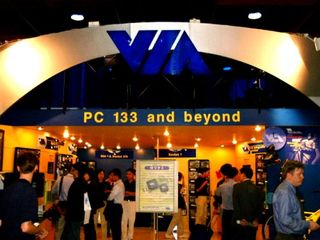Preview of VIA's upcoming Apollo Pro+ 133 Chipset
Summary

Today at Computex I had the chance to speak to Wen-chi Chen, the President and CEO of VIA. He was not aware of the rather low performance of the Apollo Pro+ 133 chipset, but so far VIA has only used some synthetic memory and CPU-benchmarks. Many motherboard manufacturers including EpoX could also not give me any serious input about their performance expectations of VIA's PC133-chipset. However, FIC and Asus were frankly telling me that they also found the VIA PC133-solution lacking behind Intel's current BX-platform. Enhanced Memory Systems asked me to test their PC133 HSDRAM on an overclocked BX-platform rather than on a PC133-motherboard, because they were disappointed with the results of Apollo Pro+ 133 too. I hope that VIA can put some more work into the chipset as well as into the BIOS of the PC133 motherboards, to offer us a better performance than BX at 100 MHz FSB. I really like the idea behind PC133 and it's really about time that someone provides a competitive chipset to the almost almighty Intel products. What other hope do we have? Well, there's still Ali and SiS, but there's also AMD with K7 and the corresponding K7-chipset. One of the four could still prove that performance hungry people are not forced to wait for Intel's Camino and the expensive RDRAM. Let's see who will succeed.
Quick Chart of the Pro's and Con's of VIA's Apollo Pro+ 133
| Pro VIA's PC133 | Contra VIA's PC133 |
| Offering 133 MHz FSB with 66 MHz AGP Clock | Lower memory bandwidth than Camino with RDRAM |
| Taking advantage of the cost effective PC133 SDRAM, later also the PC133 DDR-SDRAM and virtual channel RAM, thus offering at least 1.066 GB/s memory peak bandwidth | Real world performance lacks behind expectations |
| Offering ATA-66 NOW | AGP-performance worse than BX |
| Offering AGP 4x NOW | Row 4 - Cell 1 |
| Lower platform cost compared to Intel chipset | Row 5 - Cell 1 |
Stay on the Cutting Edge
Join the experts who read Tom's Hardware for the inside track on enthusiast PC tech news — and have for over 25 years. We'll send breaking news and in-depth reviews of CPUs, GPUs, AI, maker hardware and more straight to your inbox.
Current page: Summary
Prev Page Enough With The Theory, Give Us The Benchmarking Facts! - The ResultsMost Popular

